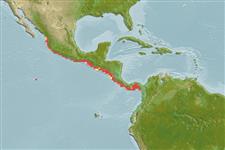>
Pleuronectiformes (Flatfishes) >
Cynoglossidae (Tonguefishes) > Symphurinae
Etymology: Symphurus: Greek, syn, symphysis = grown together + Greek, oura = tail (Ref. 45335); melasmatotheca: From the Greek word melasma, a black spot, and theke meaning a case or covering, referring to the black peritoneum; the epithet treated as a noun in apposition (Ref. 10739).
Environment: milieu / climate zone / depth range / distribution range
Ecología
marino demersal; rango de profundidad 15 - 111 m (Ref. 9294), usually 15 - 60 m (Ref. 9294). Tropical; 24°N - 6°N
Eastern Pacific: Mexico to Panama. Recorded from Peru (Ref. 10739).
Tamaño / Peso / Age
Maturity: Lm ? range ? - ? cm
Max length : 13.6 cm SL macho / no sexado; (Ref. 9294); common length : 11.0 cm SL macho / no sexado; (Ref. 9294)
Short description
Claves de identificación | Morfología | Morfometría
Espinas dorsales (total) : 0; Radios blandos dorsales (total) : 90 - 98; Espinas anales: 0; Radios blandos anales: 74 - 80; Vértebra: 49 - 52.
Probably taken as bycatch of trawl fisheries (Ref. 9294).
Life cycle and mating behavior
Maturities | Reproducción | Spawnings | Egg(s) | Fecundities | Larva
Munroe, T.A., F. Krupp and M. Schneider, 1995. Cynoglossidae. Lenguas, lenguetas. p. 1039-1059. In W. Fischer, F. Krupp, W. Schneider, C. Sommer, K.E. Carpenter and V. Niem (eds.) Guia FAO para Identification de Especies para lo Fines de la Pesca. Pacifico Centro-Oriental. 3 Vols. FAO, Rome. (Ref. 9294)
IUCN Red List Status (Ref. 130435)
Threat to humans
Harmless
Human uses
Herramientas
Special reports
Download XML
Fuentes de Internet
Estimates based on models
Preferred temperature (Ref.
123201): 19.8 - 28.9, mean 27.5 °C (based on 66 cells).
Phylogenetic diversity index (Ref.
82804): PD
50 = 0.5000 [Uniqueness, from 0.5 = low to 2.0 = high].
Bayesian length-weight: a=0.01445 (0.00647 - 0.03228), b=3.05 (2.85 - 3.25), in cm total length, based on LWR estimates for this (Sub)family-body shape (Ref.
93245).
Nivel trófico (Ref.
69278): 3.3 ±0.4 se; based on size and trophs of closest relatives
Resiliencia (Ref.
120179): Alto, población duplicada en un tiempo mínimo inferior a 15 meses (Preliminary K or Fecundity.).
Fishing Vulnerability (Ref.
59153): Low vulnerability (10 of 100).
